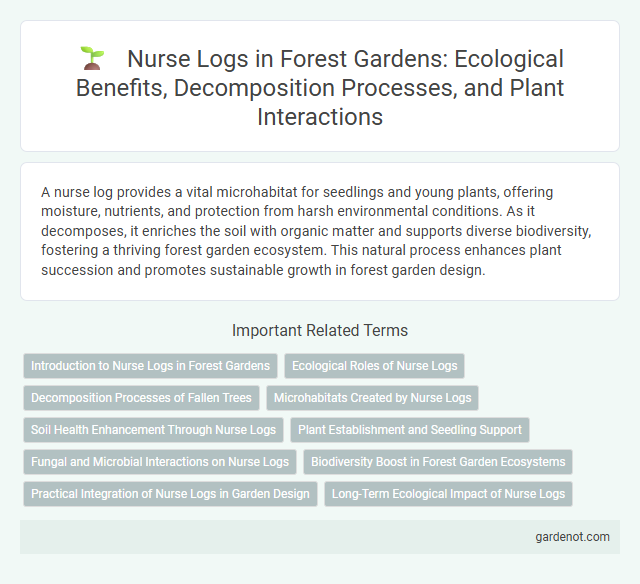A nurse log provides a vital microhabitat for seedlings and young plants, offering moisture, nutrients, and protection from harsh environmental conditions. As it decomposes, it enriches the soil with organic matter and supports diverse biodiversity, fostering a thriving forest garden ecosystem. This natural process enhances plant succession and promotes sustainable growth in forest garden design.
Introduction to Nurse Logs in Forest Gardens
Nurse logs are fallen trees that provide a nutrient-rich, moist environment essential for seedling growth and biodiversity in forest gardens. These decaying logs foster beneficial microbial activity and support fungi, which enhance soil fertility and plant health. Incorporating nurse logs into forest garden design promotes natural regeneration and sustainable ecosystem development.
Ecological Roles of Nurse Logs
Nurse logs provide critical habitats by retaining moisture and nutrients, fostering seedling establishment and growth in forest ecosystems. They create microhabitats that enhance biodiversity by supporting fungi, mosses, and invertebrates, which contribute to nutrient cycling. These decaying logs also stabilize soil and promote forest regeneration by facilitating tree succession and carbon storage.
Decomposition Processes of Fallen Trees
Nurse logs play a crucial role in forest ecosystems by facilitating the decomposition processes of fallen trees, which enrich soil nutrient cycling. Fungi, bacteria, and invertebrates break down the woody material, accelerating organic matter conversion into humus that supports new plant growth. This natural decomposition enhances forest garden biodiversity and promotes sustainable soil fertility.
Microhabitats Created by Nurse Logs
Nurse logs create essential microhabitats by providing moisture, nutrients, and shelter that support diverse plant and animal species in forest gardens. These decaying logs foster mosses, fungi, and seedlings, which establish a thriving ecosystem on their surfaces and within their decomposing matter. The microhabitats formed enhance biodiversity and promote ecological resilience in forest restoration and garden management.
Soil Health Enhancement Through Nurse Logs
Nurse logs play a critical role in forest garden ecosystems by enhancing soil health through natural decomposition processes that release essential nutrients like nitrogen, phosphorus, and potassium back into the soil. Their decaying wood improves soil structure and moisture retention, creating an ideal microhabitat for beneficial microorganisms, fungi, and plant roots. This nutrient-rich environment promotes robust plant growth and biodiversity, contributing to sustainable soil fertility and ecosystem resilience.
Plant Establishment and Seedling Support
Nurse logs provide vital support for plant establishment by creating a nutrient-rich, moist microhabitat that enhances seedling survival and growth. Decomposing wood in nurse logs releases essential nutrients and maintains soil moisture, promoting root development and reducing competition from surrounding vegetation. Seedlings benefit from the elevated, protected environment nurse logs offer, allowing for stronger establishment in forest garden ecosystems.
Fungal and Microbial Interactions on Nurse Logs
Nurse logs serve as vital substrates for diverse fungal and microbial communities that decompose wood and recycle nutrients in forest garden ecosystems. Mycorrhizal fungi form symbiotic relationships with emerging seedlings on nurse logs, enhancing nutrient uptake and plant growth. Microbial activity within nurse logs accelerates organic matter breakdown, fostering soil fertility and supporting forest regeneration.
Biodiversity Boost in Forest Garden Ecosystems
Nurse logs serve as vital biodiversity hotspots within forest garden ecosystems by providing a nutrient-rich substrate that supports the growth of fungi, mosses, and a variety of plant seedlings. These decaying logs enhance soil moisture retention and create microhabitats for insects, amphibians, and microorganisms, fostering complex food webs and ecological interactions. Their presence accelerates natural succession and promotes species diversity, ultimately boosting resilience and productivity in sustainable forest garden designs.
Practical Integration of Nurse Logs in Garden Design
Nurse logs serve as natural seedbeds, providing moisture retention and nutrient-rich environments that promote seedling growth in forest gardens. Incorporating nurse logs into garden design enhances biodiversity by supporting fungi, mosses, and insects essential for ecosystem health. Strategically placing decayed logs accelerates soil regeneration, improves water retention, and fosters a sustainable microhabitat for young plants.
Long-Term Ecological Impact of Nurse Logs
Nurse logs serve as critical habitats by supporting seedling growth and biodiversity over decades, facilitating forest regeneration and resilience. Their gradual decomposition enriches soil with organic matter, enhancing nutrient cycling and carbon sequestration critical for ecosystem sustainability. Long-term ecological impacts include maintaining forest structure and promoting complex species interactions that stabilize forest dynamics over time.
Nurse log Infographic

 gardenot.com
gardenot.com